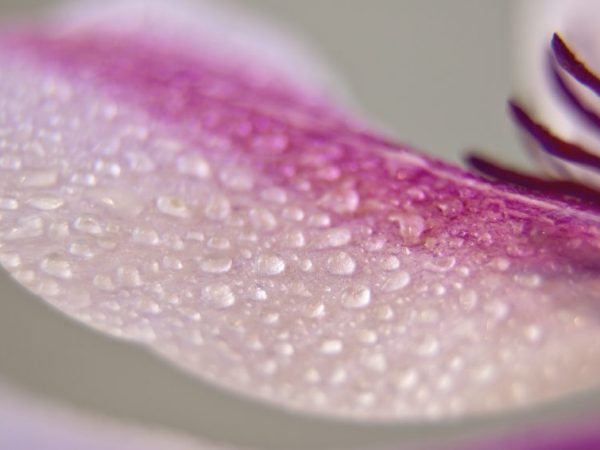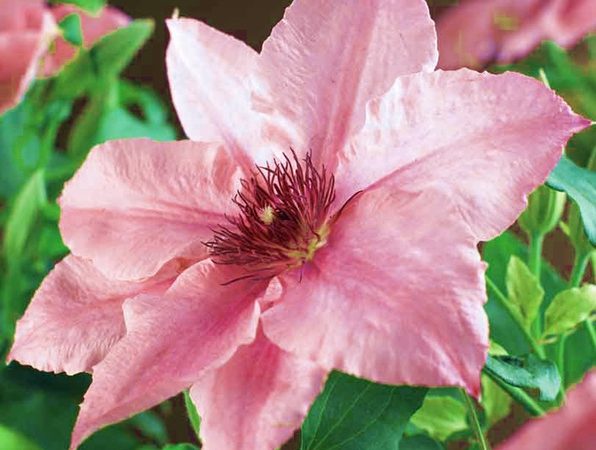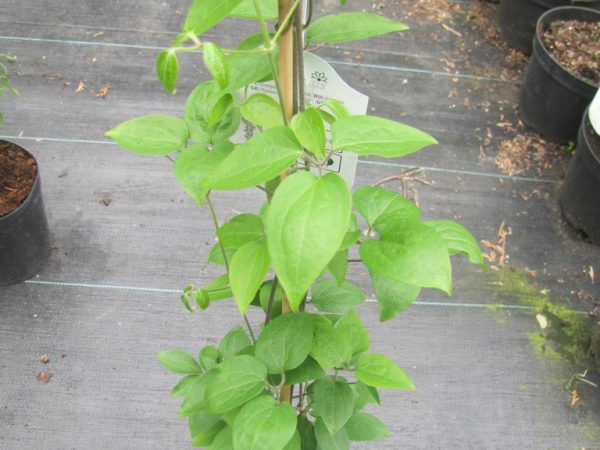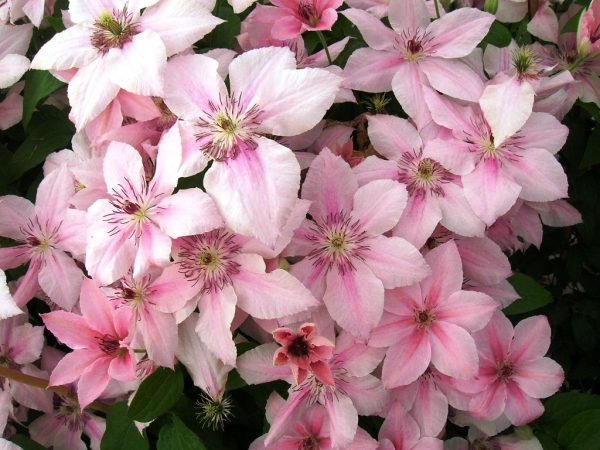Clematis Pink Fantasy - rules for caring for a blooming liana
The large-flowered Clematis Pink Fantasy was bred by the Canadian originator Jim Fisk and registered in 1975. This hybrid is characterized by high frost resistance, due to which it grows well in the northern regions of Russia.

Clematis pink fantasy
Description of the variety
Clematis Pink Fantasy grows up to 2.5 meters in height. At the same time, the tree grows very quickly: shoots can add up to 12 cm per day.
The flowers are large, about 15 cm in diameter, delicate pink in color. On sepals, 5-7 wedge-shaped petals are formed, with a darker vein in the center. The corolla is purple. Leaves are light green, medium in size, arranged in three on the petiole.
Clematis begin to bloom profusely in July, flowers appear on young shoots.
The root system is superficial, therefore, as the plant grows, it independently clings to the support.
Landing features
Timing
The timing of planting clematis depends on the region.
- In the south - from early October to late November.
- In the middle lane - in September.
- In the northern regions - at the end of April, provided that the soil warms up sufficiently.
Preparatory work
Clematis are grown in a sunny and sheltered area. It is important to provide light shading so that the roots do not dry out due to their proximity to the soil surface.
In order not to form stagnant water after rains, plants are planted on a hill.
When disembarking along the walls of a house or outbuilding, you need to retreat about 50 cm so that water does not drain from the roof onto the vines.
The seedlings are sold with open and closed roots in garden shops. It is also permissible to acquire rhizomes without shoots, however, seedlings at the age of 1-2 years take root better.
When buying, you should pay attention to the condition of the shoots - in healthy specimens they are strong and elastic, with ripe buds.
If the roots are open, they should not show signs of decay, mold, yellowed areas.
If clematis is in a container, make sure that the soil is well moistened and free of impurities.
Landing technology
It is recommended to prepare the soil for Pink Fantasy in advance (if planting is planned in the spring, then the preparation is carried out in the fall).

Clematis pink fantasy photo description
The planting site needs to be dug into two bayonets of a shovel, remove weeds with roots and apply mineral fertilizer.
With regard to the composition of the soil, neutral soil acidity with an abundant humus content is suitable.
Stages:
- A hole is dug before planting. Size: 60 cm in length and the same in depth and width.
- Drainage is placed on the bottom with a layer of 10-15 cm (broken brick or gravel is used).
- Next, humus, peat, sand, dolomite flour and superphosphate are mixed. The resulting soil mixture must be divided into two unequal parts. Most of the mixture is laid out on the drain and a slide is formed.A seedling is placed on it, spreading the roots, and a support is installed.
- The roots of the plant are sprinkled with the remains up to the first internode.
- The soil under the clematis is tamped, watered and sprinkled with mulch.
If you plan to plant several clematis nearby, then the distance between them should be about a meter.
Care
Watering and feeding
Clematis is watered once a week and abundantly. There are about 10-15 liters of water per bush.

Fantasy grandiflorum pink
You can use this technique: dig a plastic container with holes near the root of the plant and pour water into it, so the moisture will flow gradually and deeply.
You need to feed from the second year of planting: in the spring, nitrogen fertilizers are applied, during the flowering period - potash fertilizers, and after flowering - phosphorus fertilizers.
Mulching and loosening
It is imperative to mulch the soil under clematis, since their root system does not tolerate overheating and drying out. Suitable mulches include straw, grass cuttings, wood chips, peat and horse manure.
After watering, the root zone is loosened, and the eroded layer of mulch is poured.
Pruning
Clematis varieties differ in color and variety of shapes. They also have different flowering periods, according to this criterion, plants are divided into three groups:
- The first is flowering on last year's shoots.
- The second - both on old shoots and on shoots of the current year.
- The third is only for young people.
Pink Fantasy belongs to the 3rd group. You need to cut it in the fall, leaving 2-3 buds on the shoot.
Preparing for winter
Pink Fantasy is frost-resistant, but needs shelter in order to protect the roots from the flow of melt water in the spring. To do this, the seedling is covered with spruce branches, and a wooden box with a fixed covering material is installed on top.
Bamboo sticks, wooden trellises and even undersized trees are used as support. It is important that the height of the support is equal to, or slightly more than, the liana.
Reproduction
Pink Fantasy is propagated by cuttings, pinching and layering. The seed method is also possible, but the young in this case will bloom less abundantly, and the flowers will not be so large.

Clematis pink fantasy band trim
Cuttings
The procedure is carried out in late spring or early summer. To do this, choose strong shoots with one internode and a pair of leaves and buds.
At the shoot, cut off the middle part so that 3-4 cm remain above the node, and 1-3 cm below. Next, the cutting should be treated with root root and placed in a nutrient mixture of one part of sand and two parts of humus.
The planted stalk is covered with a film or a plastic bottle. The optimum temperature for germination is 25 °. Rooting takes place on average in a month and a half. Then the cuttings can be grown outdoors.
Layers
This method is used most often. To do this, in the fall, a strong vine shoot is chosen and placed in a previously dug groove 7-8 cm deep. The shoot is fixed with wire brackets and sprinkled with nutritious soil. The next year, young clematis can be separated from the mother plant.
Dividing the bush
The method is suitable for clematis at the age of 5-6 years. Older plants are difficult to separate due to the strong root, and younger plants may not tolerate the procedure.
The bush is dug, shaken off the soil and divided into 3-4 parts with a sharp pruner so that on each plot there are several shoots and a developed root bunch. Next, the seedlings are placed in the pits, covered with soil and cut off at the level of the second bud.
Diseases and pests
Most often, clematis suffer from fusarium and wilt. These are fungal diseases, therefore, for prevention, it is important to avoid excessive moisture in the plants.

Clematis pink fantasy
With signs of fusarium, damaged shoots are cut and burned, and healthy ones are treated with Bordeaux liquid or copper sulfate. When wilting (wilt), fungicides are used.
Of the insects for Pink Fantasy, the most dangerous are spider mites and aphids. To combat them, universal insecticides and acaricides are used.And for prevention, marigolds and calendula are planted next to them - with their smell, these flowers scare away insects.
Use in landscape design
In garden design, Clematis Pink Fantasy can be used to decorate fences, railings, arches. These plants also look beautiful in group planting with decorative perennials.
They are also great for balconies and terraces as they grow well in containers.
Testimonials
There are many positive reviews about Pink Fantasy posted on the gardening forums. Their authors describe the plant as being unpretentious to care for and rarely susceptible to disease. They love the abundance of flowers on clematis that appears the following year. Also, they note the ease of reproduction of the plant and recommend once every five years to "rejuvenate" the bushes by dividing.

